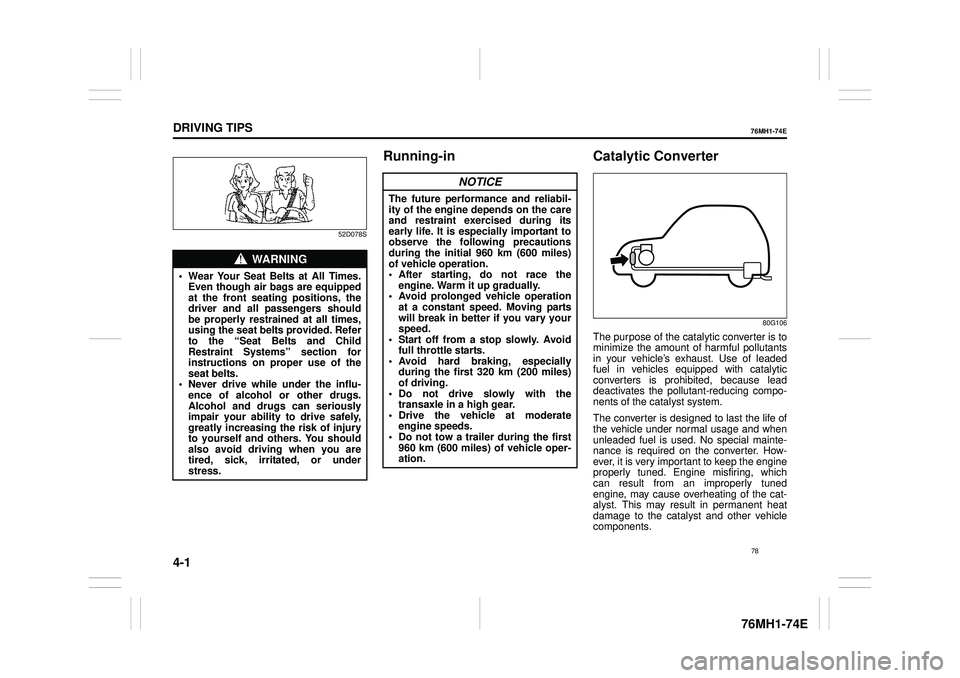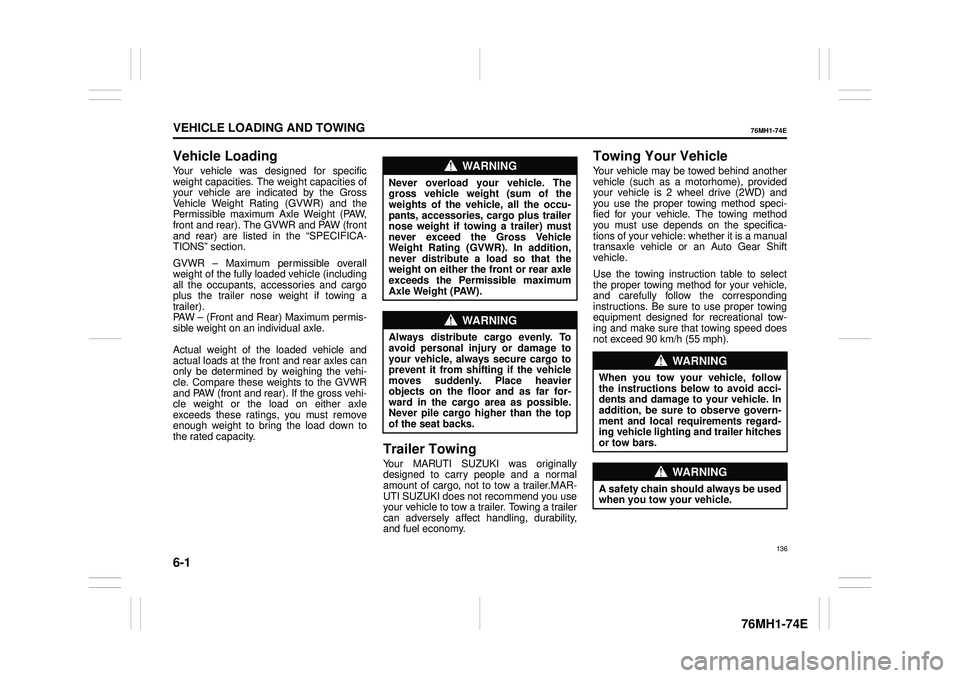trailer SUZUKI CELERIO 2020 Owners Manual
[x] Cancel search | Manufacturer: SUZUKI, Model Year: 2020, Model line: CELERIO, Model: SUZUKI CELERIO 2020Pages: 201, PDF Size: 5.82 MB
Page 89 of 201

4-1
DRIVING TIPS
76MH1-74E
76MH1-74E
52D078S
Running-in Catalytic Converter
80G106
The purpose of the catalytic converter is to minimize the amount of harmful pollutantsin your vehicle’s exhaust. Use of leaded fuel in vehicles equipped with catalytic converters is prohibited, because leaddeactivates the pollutant-reducing compo- nents of the catalyst system.
The converter is designed to last the life of the vehicle under normal usage and when unleaded fuel is used. No special mainte-nance is required on the converter. How- ever, it is very important to keep the engine properly tuned. Engine misfiring, whichcan result from an improperly tuned engine, may cause overheating of the cat- alyst. This may result in permanent heatdamage to the catalyst and other vehicle components.
WA R N I N G
• Wear Your Seat Belts at All Times. Even though air bags are equippedat the front seating positions, the driver and all passengers should be properly restrained at all times,using the seat belts provided. Refer to the “Seat Belts and Child Restraint Systems” section forinstructions on proper use of the seat belts. • Never drive while under the influ-ence of alcohol or other drugs. Alcohol and drugs can seriously impair your ability to drive safely,greatly increasing the risk of injury to yourself and others. You should also avoid driving when you aretired, sick, irritated, or under stress.
NOTICE
The future performance and reliabil- ity of the engine depends on the care and restraint exercised during its early life. It is especially important toobserve the following precautions during the initial 960 km (600 miles) of vehicle operation.• After starting, do not race the engine. Warm it up gradually. • Avoid prolonged vehicle operationat a constant speed. Moving parts will break in better if you vary your speed.• Start off from a stop slowly. Avoid full throttle starts. • Avoid hard braking, especiallyduring the first 320 km (200 miles) of driving. • Do not drive slowly with thetransaxle in a high gear. • Drive the vehicle at moderate engine speeds.• Do not tow a trailer during the first 960 km (600 miles) of vehicle oper- ation.
78
Page 146 of 201

VEHICLE LOADING AND TOWING
76MH1-74E
76MH1-74E
135
VEHICLE LOADING AND TOWINGVehicle Loading ................................................................... 6-1
Trailer Towing ...................................................................... 6-1
Towing Your Vehicle ........................................................... 6-1
Page 147 of 201

6-1
VEHICLE LOADING AND TOWING
76MH1-74E
76MH1-74E
Vehicle Loading
Your vehicle was designed for specific weight capacities. The weight capacities ofyour vehicle are indicated by the Gross Vehicle Weight Rating (GVWR) and the Permissible maximum Axle Weight (PAW,front and rear). The GVWR and PAW (front and rear) are listed in the “SPECIFICA- TIONS” section.
GVWR – Maximum permissible overall weight of the fully loaded vehicle (includingall the occupants, accessories and cargo plus the trailer nose weight if towing a trailer).PAW – (Front and Rear) Maximum permis- sible weight on an individual axle.
Actual weight of the loaded vehicle and actual loads at the front and rear axles can only be determined by weighing the vehi-cle. Compare these weights to the GVWR and PAW (front and rear). If the gross vehi- cle weight or the load on either axleexceeds these ratings, you must remove enough weight to bring the load down to the rated capacity.
Trailer Towing
Your MARUTI SUZUKI was originallydesigned to carry people and a normal amount of cargo, not to tow a trailer.MAR- UTI SUZUKI does not recommend you useyour vehicle to tow a trailer. Towing a trailer can adversely affect handling, durability, and fuel economy.
Towing Your Vehicle
Your vehicle may be towed behind anothervehicle (such as a motorhome), providedyour vehicle is 2 wheel drive (2WD) and you use the proper towing method speci- fied for your vehicle. The towing methodyou must use depends on the specifica- tions of your vehicle: whether it is a manual transaxle vehicle or an Auto Gear Shiftvehicle.
Use the towing instruction table to select the proper towing method for your vehicle, and carefully follow the corresponding instructions. Be sure to use proper towingequipment designed for recreational tow- ing and make sure that towing speed does not exceed 90 km/h (55 mph).
WA R N I N G
Never overload your vehicle. Thegross vehicle weight (sum of theweights of the vehicle, all the occu- pants, accessories, cargo plus trailer nose weight if towing a trailer) mustnever exceed the Gross Vehicle Weight Rating (GVWR). In addition, never distribute a load so that theweight on either th e front or rear axle exceeds the Permissible maximum Axle Weight (PAW).
WA R N I N G
Always distribute cargo evenly. Toavoid personal injury or damage to your vehicle, always secure cargo to prevent it from shifting if the vehiclemoves suddenly. Place heavier objects on the floor and as far for- ward in the cargo area as possible.Never pile cargo higher than the top of the seat backs.
WA R N I N G
When you tow your vehicle, follow the instructions below to avoid acci-dents and damage to your vehicle. In addition, be sure to observe govern- ment and local requirements regard-ing vehicle lighting and trailer hitches or tow bars.
WA R N I N G
A safety chain should always be used when you tow your vehicle.
136